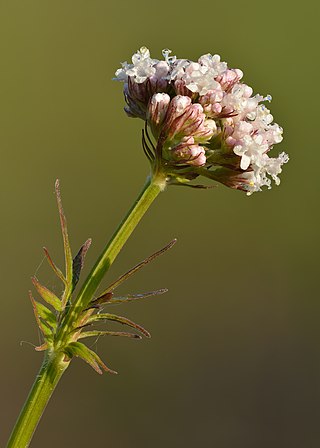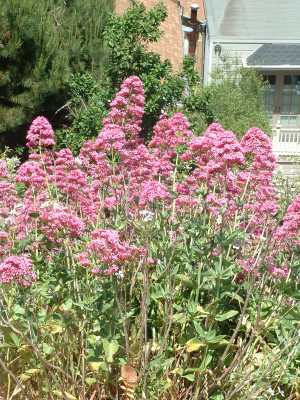
Valerian is a perennial flowering plant native to Europe and Asia. In the summer when the mature plant may have a height of 1.5 metres, it bears sweetly scented pink or white flowers that attract many fly species, especially hoverflies of the genus Eristalis. It is consumed as food by the larvae of some Lepidoptera species, including the grey pug.

Variegation is the appearance of differently coloured zones in the leaves and sometimes the stems and fruit of plants. Species with variegated individuals are sometimes found in the understory of tropical rainforests, and this habitat is the source of a number of variegated houseplants. Variegation is caused by mutations that affect chlorophyll production or by viruses, such as mosaic viruses, which have been studied by scientists. The striking look of variegated plants is desired by many gardeners, and some have deliberately tried to induce it for aesthetic purposes. There are a number of gardening books about variegated plants, and some gardening societies specialize in them.

The Valerianaceae Batsch, the valerian family, was a family of flowering plants that is now considered part of the Caprifoliaceae. Plants are generally herbaceous, and their foliage often has a strong, disagreeable odor. They are found native in most regions of the world except for Australia. Some species are cultivated as ornamentals or used in herbal medicine for inducing relaxation and sleep.

Valeric acid or pentanoic acid is a straight-chain alkyl carboxylic acid with the chemical formula CH3(CH2)3COOH. Like other low-molecular-weight carboxylic acids, it has an unpleasant odor. It is found in the perennial flowering plant Valeriana officinalis, from which it gets its name. Its primary use is in the synthesis of its esters. Salts and esters of valeric acid are known as valerates or pentanoates. Volatile esters of valeric acid tend to have pleasant odors and are used in perfumes and cosmetics. Several, including ethyl valerate and pentyl valerate are used as food additives because of their fruity flavors.

Valeriana is a genus of flowering plants in the family Caprifoliaceae, members of which may by commonly known as valerians. It contains many species, including the garden valerian, Valeriana officinalis. Species are native to all continents except Antarctica, with centers of diversity in Eurasia and South America.

Hosta is a genus of plants commonly known as hostas, plantain lilies and occasionally by the Japanese name gibōshi. Hostas are widely cultivated as shade-tolerant foliage plants. The genus is currently placed in the family Asparagaceae, subfamily Agavoideae, and is native to northeast Asia. Like many "lilioid monocots", the genus was once classified in the Liliaceae. The genus was named by Austrian botanist Leopold Trattinnick in 1812, in honor of the Austrian botanist Nicholas Thomas Host. In 1817, the generic name Funkia was used by German botanist Kurt Sprengel in honor of Heinrich Christian Funck, a collector of ferns and alpines; this was later used as a common name and can be found in some older literature.

Nymphaea lotus, the white Egyptian lotus, tiger lotus, white lotus, or Egyptian water-lily, is a flowering plant of the family Nymphaeaceae.

A leaf miner is any one of numerous species of insects in which the larval stage lives in, and eats, the leaf tissue of plants. The vast majority of leaf-mining insects are moths (Lepidoptera), sawflies, and flies (Diptera). Some beetles also exhibit this behavior.
The field elm cultivar Ulmus minor 'Silvery Gem' is an ornamental clone raised, as Ulmus carpinifolia 'Silvery Gem', before 1965 by P. G. Zwijnenburg of Zwijnenburg nurseries, Boskoop, The Netherlands.

Persicaria virginiana, also called jumpseed, Virginia knotweed or woodland knotweed is a North American species of smartweed within the buckwheat family. It is unusual as a shade-tolerant member of a mostly sun-loving genus. Jumpseed is a perennial, named for its seeds which can "jump" several feet when a ripe seedpod is disturbed.

The Circumboreal Region in phytogeography is a floristic region within the Holarctic Kingdom in Eurasia and North America, as delineated by such geobotanists as Josias Braun-Blanquet and Armen Takhtajan.

Actinidia kolomikta, the kolomikta, miyamatatabi, super-hardy kiwi, or variegated-leaf hardy kiwi, is a species of flowering plant in the family Actinidiaceae, native to temperate mixed forests of the Russian Far East, Korea, Japan and China.

Valeriana congesta, synonym Plectritis congesta, is a species of flowering plant in the honeysuckle family. It is known by several common names, including shortspur seablush and rosy plectritis. It is native to western North America.

Cyclamen balearicum, the Majorca or Balearic cyclamen, St. Peter's violet or sowbread, is a perennial plant growing from a tuber, native to shady areas in woodland of short evergreen trees and shrubs up to 1,443 m (4,734 ft) above sea level in the Balearic Islands and in isolated locations in France from the Pyrenees to the Rhone valley.

Valeriana pauciflora, commonly called the largeflower valerian, is a plant species in the Caprifoliaceae. It is native to the Eastern United States, where it is found in the regions of the Interior Low Plateau, the Ohio River drainage, and the Potomac River Valley. In this region, it is found in very nutrient-rich, mesic forest communities, often in stream valleys or lower slopes.

Valeriana dioica, the marsh valerian, is a species of flowering plant in the genus Valeriana, native to Europe and Anatolia. It is typically found in calcareous fens. It is a dioecious species, with male and female flowers on separate individuals, and it is pollinated by small flies.

Valeriana graciliflora is a species of flowering plant in the family Caprifoliaceae.















